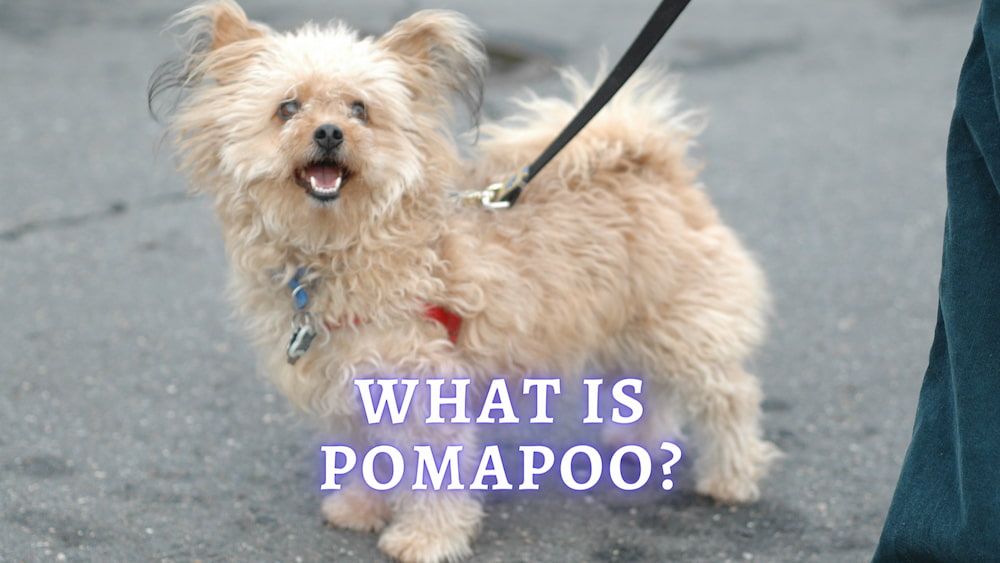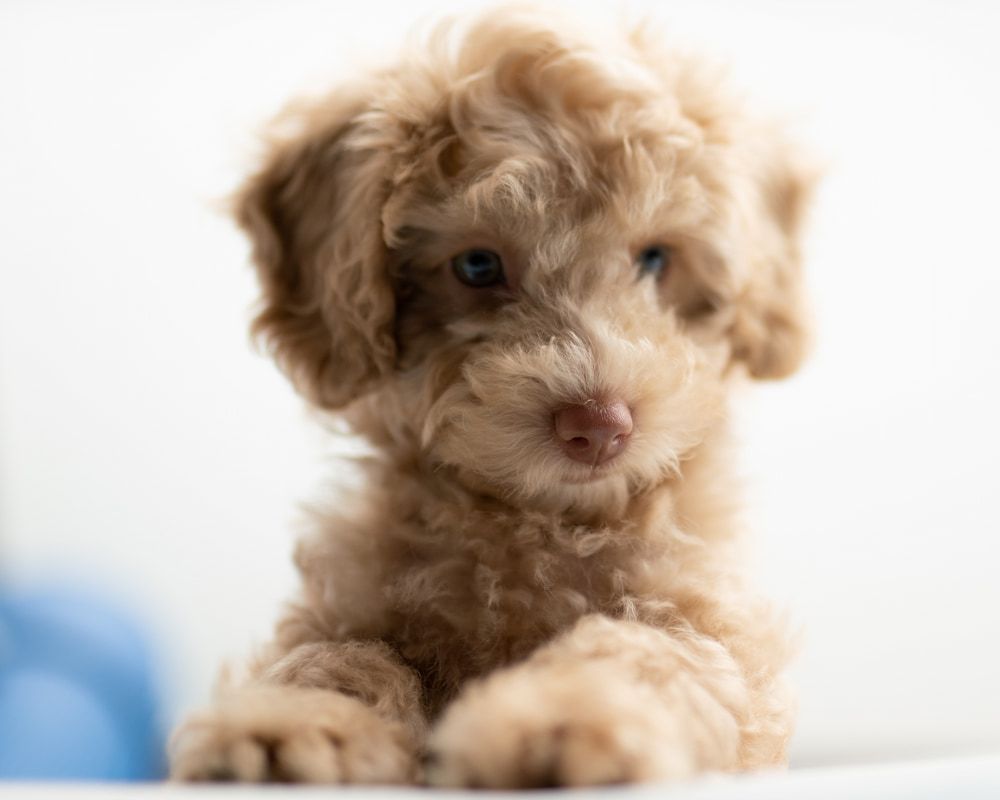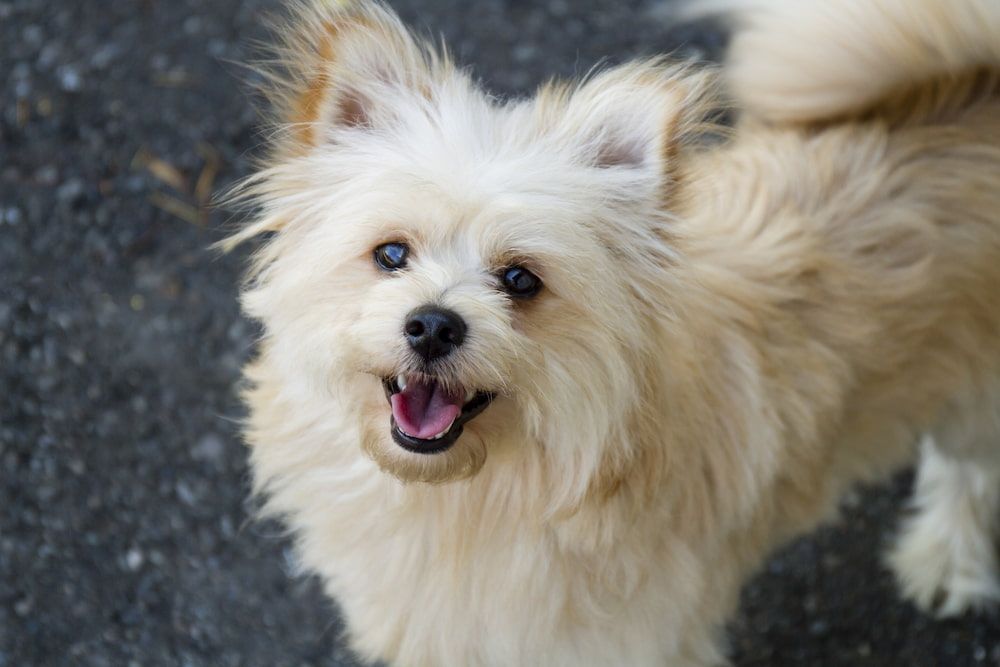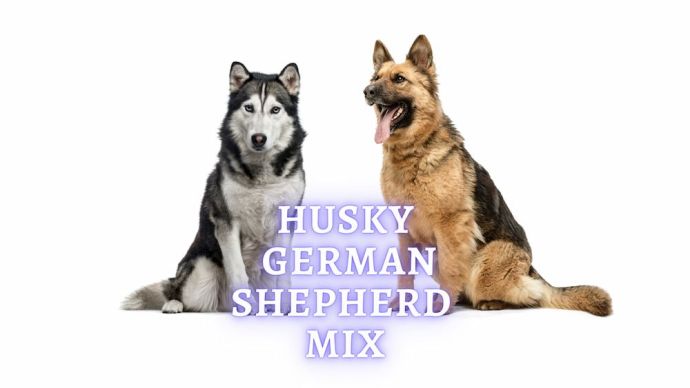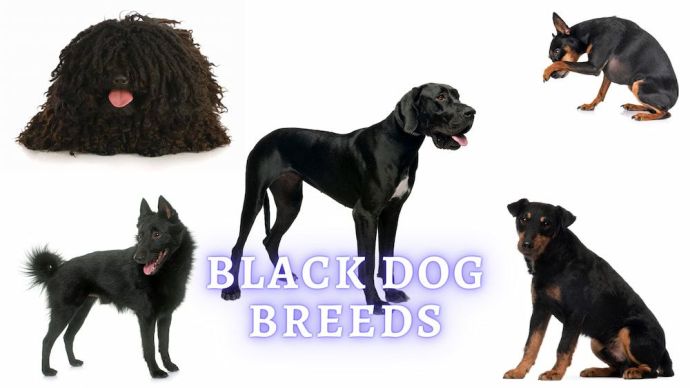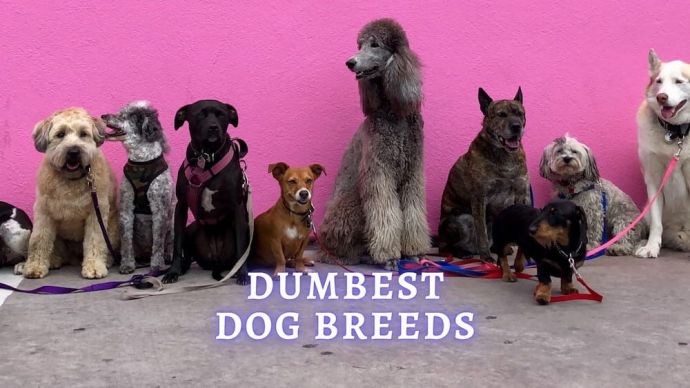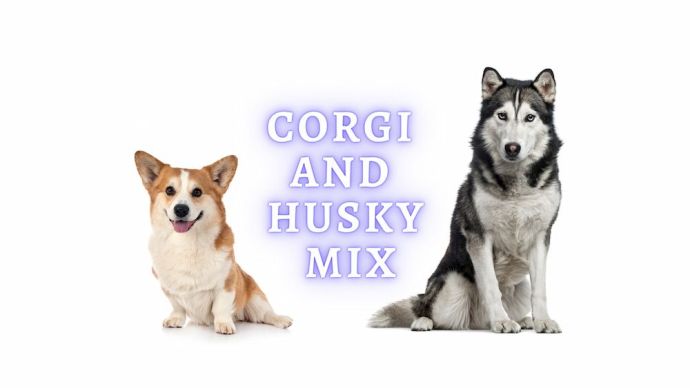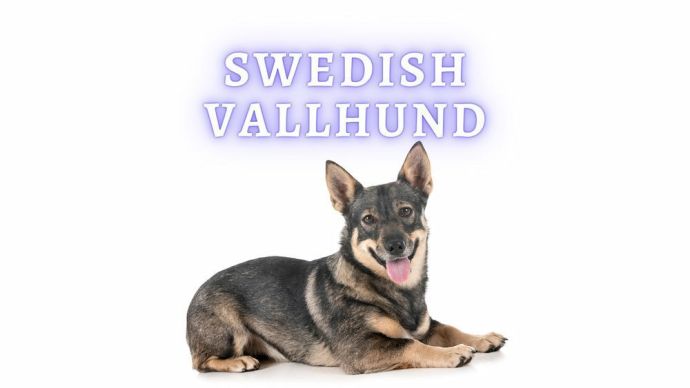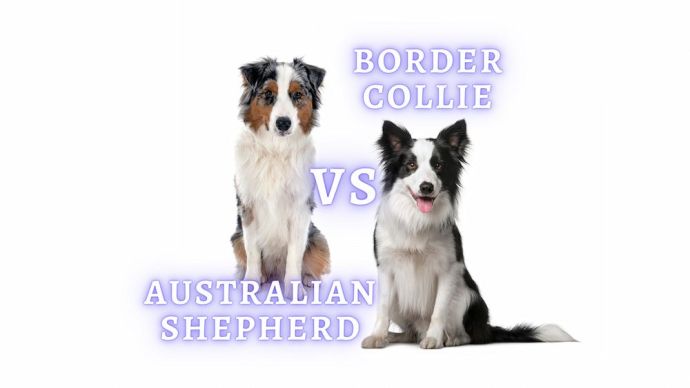Pomapoo: All You Need to Know About Pomeranian Poodle Mix
Written by:
Author: Vicki Smirnova
Vicki Smirnova is a professional writer and editor who adores animals and helps readers get along well with their pets. She has been working in digital media for more than 5 years and has great experience writing content about lifestyle, including pets. Vicki specializes in dog health and nutrition, cat feeding, dog training. She is an aquarium lover and is passionate to write about fish care at home. Also, Vicki headed several websites and worked as a news editor.
View all 245 articlesLearn about our editorial process and veterinary review board.
Viewed: 68
Updated on: 05/24/2023
What is Pomapoo?
The Pomapoo, a hybrid between a pomeranian and a poodle, is a “designer” breed and is very popular. The Pomapoo is an intelligent dog that talks to people and listens to their commands.
Breed History
People have crossed different types of dogs for thousands of years, trying to achieve a specific appearance, temperament, or performance. The pomeranian-toy poodle mix originated in the late 1990s as designer breeds became popular in North America.
However, the genetic characteristics of each dog are formed randomly. Therefore, it cannot be said that you will get the best attributes from these breeds when crossing dogs. Remember genetic diseases that may affect parent breeds.
Parent Breeds
Pomeranian
Distant relatives of spitz are Eskimo dogs and Samoyed huskies. Representatives of these breeds acquired their miniature sizes only through selection.
Regardless of size, the spitz feels like a big dog and often has a cocky personality. Spitz is an active, cheerful, mobile dog, always ready for walks and games. Firmly attached to their owner, they do not tolerate separation well. The disadvantage of the small-sized spitz is frequent high-pitched barking. All spitz are good guards, and if they cannot scare with their weight, then, in this case, they bark long and piercingly.
In spitz, the following genetically determined anomalies and pathologies occur false polydipsia, tracheal collapse, patent ductus arteriosus, medial patellar luxation, cryptorchidism, portosystemic shunts, and sensitive digestion. With age, spitz can develop heart valve disease (endocarditis), tartar, chronic rhinitis, and laryngotracheitis. Spitz is prone to heatstroke and skin inflammation.
In any case, it is worth remembering that there is no breed of dog whose representatives never get sick with anything. Buying puppies only from trusted breeders and born by parents with a healthy pedigree is essential, and this minimizes the likelihood of genetic pathologies. To prevent diseases, it is necessary to conduct a general medical examination by a veterinarian at least once a year.
READ MORE: Japanese Spitz Breed Profile
Toy Poodle
France is recognized as the official country of origin of the modern poodle; however, there are many more theories about the formation of this breed. According to one of them, the first images of a poodle were found in Roman tombs; according to another, the dogs were bred in Germany and were imported to Europe from Tibet.
The toy poodle is a classic companion pet with a sharp mind and a need for tough training. Poodles love to jump over the ring, overcome obstacles and perform circus acts. However, any dog, even the most obedient, can be spoiled by improper upbringing. A spoiled dog becomes nervous and hypersensitive. It can bark and whine for no apparent reason, not follow commands and even bite.
According to statistics, the toy poodle is considered to have a long liver. But if the parents are chosen incorrectly, the dog may suffer from the following diseases: progressive retinal atrophy, cataract, dislocation of the kneecap, von Willebrand’s disease (long-healing cuts, nosebleeds, and bleeding gums), and thyroid disorders (tendency to gain weight, oily or dry skin, skin infections, hair loss).
Fun facts about the Pomeranian Poodle Mix
- Pomapoos are not very active; thus, they are suitable for owners who do not like to walk their dogs.
- They are companion dogs and love to be around family.
- Before the age of 16 weeks, puppies should be actively socialized, taken to different places, and accustomed to different sounds and people.
Appearance
It is very difficult to predict what a pomapoo puppy will look like. It can inherit most of its traits from one parent. However, they tend to have a compact bodies, short noses, and dense coats.
| Weight | 5-15 pounds |
| Height | 8-10 inches |
| Colors and Patterns | White, grey, brown, black, and, often, a mixture of these |
| Lifespan | 12-14 years |
| Suitable for | Retirees, singles, and owners with a lot of attention and love to give |
Parent Breeds Appearance
Pomeranians
The Pomeranian belongs to the dwarf dog breed. The Pomeranian has a small head; the broad back of the skull tapers towards the nose, thus forming a wedge. The rounded forehead contrasts with the underdeveloped occiput. Cheekbones are practically invisible due to chubby cheeks. A small and neat nose is always black (maybe brown in orange and red dogs). The same is true with lip color.
The ears are triangular and have a sharp and hard tip. The Pomeranian’s ears are droopy at birth but “raise” as the dog matures.
Small dark eyes are set obliquely; their shape is mostly almond-shaped or oval. Eyelids are black; dark brown pigmentation is acceptable in dogs of the same color.
The upper jaw of the Pomeranian overlaps the lower, thereby forming a correct scissor bite. Direct and pincer bites are not recognized as a defect. There are 42 teeth.
The strong neck is distinguished by a slightly arched shape. The length is average, and the so-called suspension is absent. The neck of the Pomeranian ends with the withers, and that ends with a short back. The chest is developed. The abdomen should be tucked up, and the ribs should be well palpable.
The tail is of medium length, set relatively high. Because the tail ring lies on the back, the dog looks miniature and rounded.
The forelimbs are set wide. The shoulders are well-muscled. The black shade of the pads and claws is characteristic of all animals of the breeds except for red, cream, and brown. The hind limbs are parallel to each other. The thighs and lower legs are in equal proportion. The small paws are not as round as the forelegs. The fingers are compressed and end in black claws and pads (brown in some dogs).
Pomeranian fur hides a dense undercoat. Short, soft hair covers the head, perky protruding ears, and the front side of the limbs. The rest of the body is characterized by long, straight hair with no curls or waves. The shoulders and coat of the dog are hidden by the mane.
The Pomeranian breed has ten coat colors: white, blue, black, cream, orange, sable, blue or black and tan, chocolate, and two-tone. Spotted coloring means white as a background color and even a distribution of markings.
Toy Poodles
The toy poodle is a dog with a slightly elongated body and fluffy hair. The back is straight. The head is held high and is wedge-shaped with a neat (not pointed) muzzle, moderate superciliary arches, a flat forehead, and cheekbones. The neck is strong and of medium length with a pronounced scruff.
The almond-shaped eyes are set wide apart at the level of the bridge of the nose. The eyelids are well-pigmented. Eye color depends on the fur color: white, black, apricot, and gray toy poodles have black or dark brown irises. Browns are dark amber.
The long, well-pubescent ears are rounded at the ends and hang down to the line of the corners of the lips, close to the cheeks, and directed towards the eyes.
The nose has a straight bridge parallel to the line of the skull, with open nostrils. The color of the nose leather depends on the color of that poodle: black, white, and gray dogs have black noses, and brown and apricot dogs have dark brown, close to black noses.
The middle teeth are in a scissor bite, where the top row of incisors closely overlaps the bottom row and is perpendicular to the jaw.
The body is slightly elongated, with slightly pronounced withers, short back and loin, rounded croup, and broad chest, lowered to the line of the elbows. The top of the sternum protrudes slightly. The poodle’s belly is moderately tucked up.
The tail is straight and well feathered; in motion, raised 45 degrees to the line of the back. It is docked at 2/3 or half of the natural length.
Forelegs of the poodle: straight, with strong shoulders equal to the length of the shoulder blades, elbows pressed to the chest, turned back, strong bones, and short mouths.
Poodle’s hindquarters: straight, with developed, slightly sloping hips and pronounced knee and hock joints. When viewed from behind, the legs are long, standing parallel to each other.
Paws are medium-sized oval, with densely collected fingers and well-pigmented pads. The color of the pads depends on the color of the poodle: black and gray dogs are black, white dogs are light brown, and apricot dogs are black or dark brown.
The coat is curly or corded. The length of the integumentary hair is the same throughout the body.
The color of that poodle can be both warm and cold but always monophonic (not spotted). Skin color depends on fur color: in black, gray, brown, and apricot poodles, the pad is in the tone of the main color; in white poodles, the pads are silver.
READ MORE: Best Food for Poodles
Pomapoo Personality
Owners of a Pomapoo note its good nature; however, you should not buy a puppy of this designer dog breed for a child. The dog needs a strong leader from whom it will find protection from larger predators. However, the puppy will not refuse to participate in outdoor games and go for a walk. In advance, explain to the child the rule of behavior with a dog. These pets do not tolerate neglect, and with frequent manifestations of rudeness, they can grow nervous and hyper-excitable.
Dogs of this breed are attached to the family in which they live and can be sad if they are not given proper attention. The dog will always be with you: while preparing dinner, taking a shower, and sleeping at night. Some animals may sleep in a room with their owner.
However, any dog, even the most obedient, can be spoiled by improper upbringing. A spoiled dog becomes nervous and hypersensitive. It can bark and whine for no apparent reason, not follow commands and even bite.
New people make a Pomapoo dog breed wary and curious. In young dogs, this can be manifested by barking. And when guests appear in the house, the dog will definitely sniff them and wag its tail in a friendly manner. This pet gets along well with other animals, especially if it grew up with other animals.
Activity Levels and Trainability
In general, dog breeders characterize the Pomapoo as a quick-witted creature that is easy to train with the right approach. Gentle handling and tasty rewards are the most effective approach to training this breed.
If the pomapoo puppies has inherited the character of the parent of the Pomeranian, then he will not take criticism well. A naughty dog will bring a lot of trouble to the dog owners, so teach your pet to perform the simplest actions: sit, lie down, approach the leg, and go to the place. The command to stop barking is no less useful: not everyone will like the high and sonorous intonations of the “voice.”
Care and Health
Both parents have a coat that is difficult to care for; therefore, from puppyhood, it is necessary to become accustomed to combing wool, bathing, and cutting. At first, the animal may resist. But if you show firmness while maintaining a friendly attitude, everything will work out.
It is not recommended to bathe a Pomapoo more than once or twice a month (as needed). Be sure to treat the dog’s velvety coat with a hair conditioner and dry it thoroughly with a hair dryer. Use a comb with long teeth. Please note that when combing, the fur should be wet, so you should always have water softened with the same conditioner on hand. The molting period requires more thorough combing.
Teeth should be cleaned with a special paste 3-4 times a week. To do this, you can use a brush or nozzle. In order to avoid the appearance of tartar and further treatment, it is recommended to include solid food in the pet’s diet.
The nails are trimmed with a toy nail clipper. Do not forget to process the resulting sharp edges with a nail file. Paw pads also deserve care.
Diet
The nutrition of these tiny dogs must be balanced. For this, dry food with the maximum content of essential minerals and vitamins is suitable. Natural food is no less useful, but in any case, do not treat the spitz with food from the table:
- Sweets;
- Milk;
- Smoked meats;
- Flour products;
- Fatty and spicy foods;
- River fish.
Food should always be fresh and at room temperature. Do not forget about the sufficient amount of water, which needs to be changed daily.
RELATED: Best Dry Dog Food
Breeders and Adoption
Before you take pomapoo puppies into the family, be sure to ask the breeder to provide information about the pomeranian and toy poodle parents (pedigree, titles, certificates of passing genetic tests). This will help to identify any shortcomings on your own.
Schedule a viewing of the puppies during the daytime hours. At this time, those dogs are especially active. Rate the look: the coat must be clean and combed, the eyes, ears, and nose without dried discharge, and the abdomen firm but not bloated. A responsible breeder teaches a puppy to groom from the first month of life. Assess the behavior.
Request documents for puppies. If you pick up a pet at 2.5 months, the baby must undergo mandatory vaccination and receive puppy cards and a veterinary passport.
People also ask
Is a Pomapoo a good dog?
These are sweet small dogs that are great for living in an apartment or small house. With proper socialization, they get along well with other dogs and people. This dog does not require excessive activity, but it can be taught to perform tricks and commands.
Does a Pomapoo bark a lot?
This mixed-breed dog is prone to barking. However, if you start training your Pomapoo puppy early enough, you can avoid this problem.
Can Pomapoos be left alone?
If you have a newborn puppy, it should not be left alone for more than 2 hours. The older the dog, the longer the time span can be. However, do not be with your pet 24/7; otherwise, it will get used to you, and it will be more difficult to leave it alone.
Are Pomapoos hypoallergenic?
Poodles have a reputation for being hypoallergenic dogs. Since the Pomapoo is a poodle hybrid, they are also considered a hypoallergenic breed.
Conclusion
This is a lively and affectionate dog that can become the most wonderful companion. It can be a good watchdog, announcing the approach of visitors, and is, generally, a kind dog. Pomapoos are unusually sensitive to voice intonation and respond well to training.
 Dog Breeds American Staffordshire Terrier Vs Pitbull: Appearance, Activity Level and Temperament Difference
Dog Breeds American Staffordshire Terrier Vs Pitbull: Appearance, Activity Level and Temperament Difference - 194
- 0
 Dog Veterinary Tips Why is my Dog throwing up: Causes and Preventing (Veterinary Advice)
Dog Veterinary Tips Why is my Dog throwing up: Causes and Preventing (Veterinary Advice) - 21360
- 5
 Dog Care My Dog Keeps Scratching His Mouth: Reasons Why Your Dog Scratching Face
Dog Care My Dog Keeps Scratching His Mouth: Reasons Why Your Dog Scratching Face - 16547
- 1









